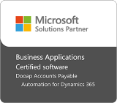There are many things businesses realized from the COVID-19 pandemic and near the top of the list was the need to automate and rationalize, as organizations struggled to keep operations going despite outdated processes and remote staff. Accounts Payable, a back-office function that is often far from the limelight, suddenly moved front and center as organizations realized the importance of processing invoices quickly from remote locations and accurately to enable payments to be made on time and keep cash flowing between organizations.
One of the reasons processing was so challenging during the pandemic is because too many organizations are still dependent on paper or bound to a certain office location. During the quarantine, someone had to physically go into the office to pick up the paper invoices, manually input them in the system and route them around for approval. And trying to handle and manage this workflow remotely without the proper processes and technology in place is extremely difficult.
Now’s the time to automate
From the lessons learned over the past few months, it’s clear that there’s no better time than now to automate AP. It’s time to say goodbye to outdated manual processes and embrace modern AP practices. Manual processing is not only a time-consuming, inefficient process for AP, but also for the broader organization – for reviewers who need to approve invoices, and Accounting and other departments that need to track down information for monthly closes and gain business insight.
At this point in time, it’s more important than ever to ensure your organization has its financial house in order and can effectively manage spend, cash and payments. With modern AP practices and automation, you will have the visibility into invoices, outstanding liabilities and available cash flow, as well as the accuracy and controls to effectively manage invoicing and payment policies. And you will be able to implement and manage it all remotely – no matter where and when.
Additionally, automation provides significant cost savings. According to market studies, implementing a modern AP automation solution to replace manual processes will cut your costs by 90%.
Challenges to overcome
Despite the pressing need for modern AP practices, there are challenges to automation that AP departments have to face. A critical issue is funding. Management often focuses on other priorities, and AP is not top of mind. Also, many company leaders are unaware of the benefits that automation can bring, not only to AP, but also to the broader organization.
But these challenges can be overcome. AP departments can make the business case for automation by showing the savings and efficiencies it can bring to the organization as a whole. Automation not only enables workers to process, review and approve invoices quickly and easily – no matter where they are located – but it also provides valuable information that can be used across the organization to better manage cash flow, spend and payments.
Fast-tracking
The good news is that it’s not hard to get AP automation underway, it’s low risk and you can experience benefits from day one. Here are four strategies to fast track AP automation in your organization:
- Get rid of paper from the start. By using a Capture-as-a-Service (CaaS) provider, you can outsource the process of turning paper-based invoices into an electronic format. That way you can get them into your system quickly and avoid the headaches of lost and missing invoices, and mounting volumes of paper. And, electronic invoices don’t require any physical interaction.
- Get your processes in order. Conduct a review to determine what processes make sense, and which can be streamlined. If a process isn’t providing value, get rid of it. See where you can gain efficiencies. For example, don’t do a task weekly that you can do monthly, and don’t involve more people in a task than needed.
- Adapt to industry standards. AP automation is a mature industry with established best practices that you can implement right out of the box. Don’t waste time and money trying to customize a solution, but rather benefit from the tried-and-true standards that have been developed from the experiences of countless companies before you.
- Implement the basics. Institute 100% PO-based processing to enable invoices to be processed quickly and provide an additional layer of control. Keep your process simple, straightforward and streamlined. Select the solution that best fits your AP operational needs.
The current environment is unpredictable and, unfortunately, no one knows how things are going to look a year or even six months from now. Be prepared and get your financial house in order so your operations can run smoothly no matter what the future holds.
Ready to learn more on how to get started?








